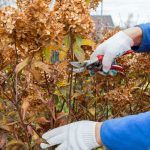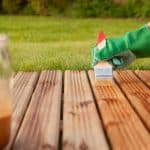Last updated on February 28th, 2022
Our site is reader supported, this means we may earn a small commission from Amazon and other affiliates when you buy through links on our site.
Growing Hydrangeas in pots is relatively simple and in order to grow your Hydrangeas in a pot you need to make sure that the soil is well-drained, the location in which you place the pot receives the appropriate amount of sunlight, and the soil remains properly moist because they need regular water and will suffer quickly if they don’t get enough.
Growing Hydrangeas in pots is a wonderful option for anyone who has a small garden or limited space and wants to add a beautiful look. This is also the perfect option for people who have locations that get adequate sunlight in the morning but not in the evening, for example, on porches, decking, balconies or patios. If you have difficult soil (soil that is simply not well-suited to Hydrangeas) you still have the opportunity to enjoy them by planting the Hydrangea in a pot with the right type of soil.
Learn more about changing the colour of a Hydrangea here.
Planting Hydrangeas in Pots
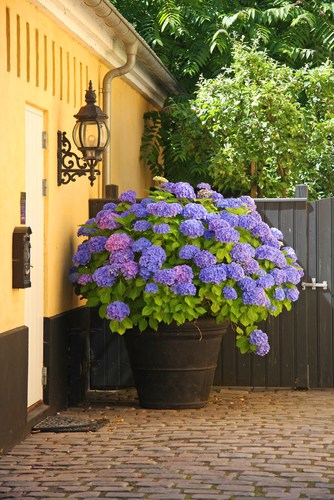
The first step is to pick out the appropriate size pot for your Hydrangea. Hydrangeas won’t do well in smaller containers, simply because their roots grow very quickly and very aggressively, which means it won’t be long before they outgrow a small pot. Smaller containers also dry out far too quickly. It is recommended that you get medium or large-sized planters and once you have picked out the planter make sure you have adequate drainage holes at the bottom, which is something that is often overlooked.
In many cases, the drainage holes that are pre-drilled into a pot are insufficient and you might need to take a drill and create a few extra holes just to add better drainage. The roots will rot if there’s insufficient drainage so it is vital you don’t skip this step. It’s also beneficial to put a flat layer of stone or broken pots at the bottom to encourage better drainage. This really is one of the most critical steps to maintaining healthy Hydrangeas.
After this, you need to select soil or compost that is designed specifically for pots and planters, and also your Hydrangea type if you are trying to produce blue or pink blooms by altering the pH level.
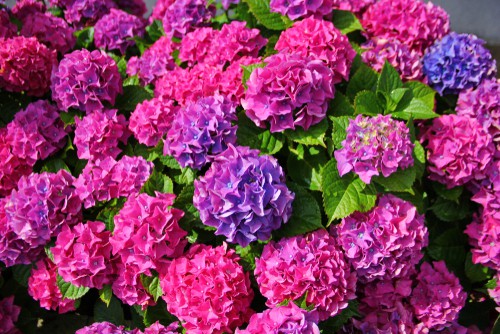
When you are ready, you want to plant your Hydrangea to the same depth as the pot it has been supplied in. This means that if you purchase your Hydrangea from a nursery and it is in an existing pot, the level at which it is buried needs to be maintained when you place it into its new pot or container at home. If you bury it too deeply it will not thrive.
You need to leave at least 20mm from the top of the soil to the top of your planter so that you can water it after you plant it without any of that water washing off. Once you place the Hydrangea in the soil, gently push down around the plant to get rid of any air pockets and keep the soil firm.
The Best Hydrangeas for Pots
No products found.
No products found.
No products found.
No products found.
The Best Compost for Hydrangeas
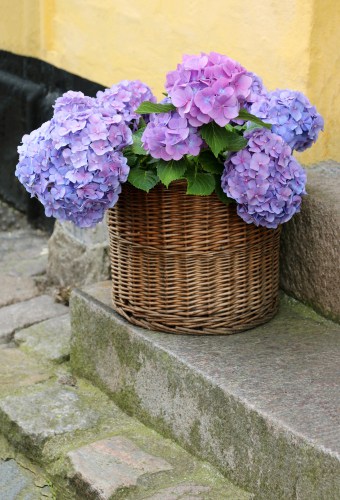
The best compost for Hydrangeas in pots is not necessarily just topsoil because it won’t drain well enough. You want to add potting soil and integrate compost into which will add more nutrients, giving your Hydrangea everything it needs to thrive.
You can go to any garden centre or nursery and purchase potting soil as well as compost and simply mix it by hand in the container before planting the Hydrangea.
You could simply go for compost that is specially made for shrubs, however, if you want to grow blue mop head Hydrangeas you need to make sure you use ericaceous compost or it will probably produce pink flowers.
Don’t forget to use ericaceous compost if your Hydrangea has blue flowers
After you have planted your Hydrangea and chosen the right compost, the maintenance required is fairly simple. Just make sure that the location of the pot meets with growing requirements for the variety of Hydrangea you have. Most Hydrangeas prefer morning sunlight and afternoon shade. If you’re planting a larger Hydrangea it’s best to choose your ideal location and then move the pot to that area, planting it directly there, rather than trying to plant a Hydrangea in a pot elsewhere and move it after the fact.
Keep the soil moist
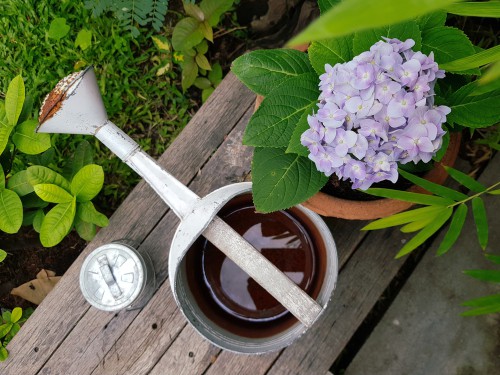
Be sure to check on the soil levels and keep the soil moist. Usually, Hydrangeas (in pots) require watering at least twice a week, however, the conditions of the weather at any given time could change and you may need to increase your watering levels. If the leaves start to droop, it’s indicative of a bit of drought. Simply water your plants. If you’re going to fertilise it, do it at the end of winter or the beginning of spring and use a slow-release fertiliser. Never feed after August because this can promote new growth that can be damaged by frost in winter.
Caring for Hydrangeas in pots during the winter
When it comes to winter, you have two options:
Option 1
The first is to bring your pots inside where they will be protected from the winter weather. It is highly recommended that you do this if possible, and keeping them in a greenhouse over winter should offer enough protection.
Option 2
The second, if they are simply too large to move inside or you don’t have space, is to create a protective barrier around the Hydrangeas. The best way to do this is to utilise stakes or sticks as well as chicken wire. Create a fence around the Hydrangea after you’ve cut it down, pack the area down with material like pine needles because this will still allow for efficient airflow. When you do this, be careful that you don’t break any of the branches. After that cover the entire structure with a breathable material like a burlap sack. Do not use something like plastic because this won’t allow airflow.
You can also now buy fleece jackets you can place over the plants now too, which could be an easier alternative. Don’t forget to wrap the pot in fleece or lagging to protect the roots.
Pruning
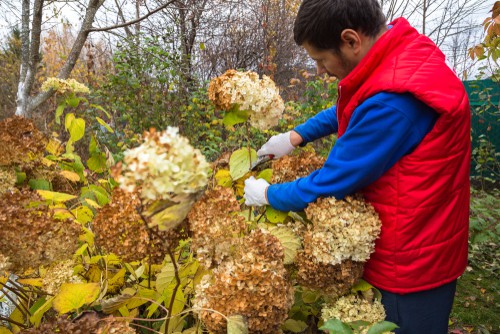
You can prune as you would if they have been grown in the ground. Most Hydrangeas in the pots can just be deadheaded to encourage new blooms. Read more on pruning hydrangeas here.
Uncredited photos: Shutterstock.com
Last update on 2025-12-30 / Affiliate links / Images from Amazon Product Advertising API




